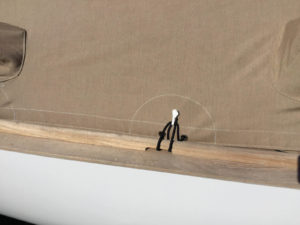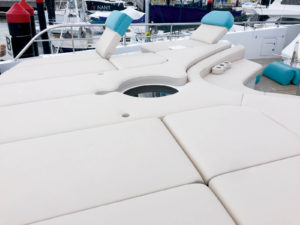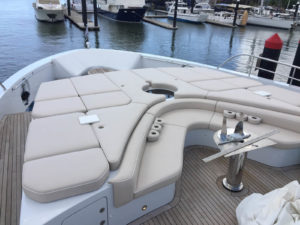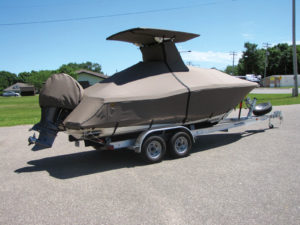Coping with material failures and client confusion

A full 6-meter bow-to-stern yacht mooring cover by SB Marine Trimming uses no new fittings; all attachment points were to the existing wooden toe-rail so that once removed, there is no evidence the boat has a cover. Fabric is Sunbrella® Tresco Brass. Photo: SB Marine Trimming.
Material meltdowns, client confusion and the wrath of Mother Nature create challenges for fabricators that require savvy skills and teeth-gritting determination.
Nearly every marine fabricator has stories about projects that went awry and failed to meet demands in one way or another. It might be thread that doesn’t hold up, a mooring cover tearing loose or the dreaded pinking of vinyl. Or perhaps it’s a last-minute project with an impossible deadline, or clients who don’t know what they want. Over time, every master crafter finds ways to overcome these forces of nature (and clients!) and some of them are recounted here, along with techniques and tried-and-true standbys to meet these challenges.
Managing client expectations is key
“We created snow globes for the 2018 Super Bowl LII [held in Minneapolis in early February] but only had eight days to produce them from start to delivery,” says Duane Smith, owner of Canvasworks, Cokato, Minn. “It used 50 to 60 yards of 30-gauge fabric, cut on a CNC plotter table, which allowed us to deliver the package to the Bowl site on a Friday before the event, two days early.”
Smith says his company got the job because a previously contracted fabricator had failed to come through. To make the deadline manageable, Canvasworks site-measured the snow globe frames using a laser and the plotting points were downloaded to their CNC cutter. “What we didn’t know was that the snow globes were to be used for on-air broadcast interviews of players, coaches and celebrities!”

To maintain adequate strength in covers, SB Marine Trimming uses twin stitching and extra reinforcing where necessary on leading edges, and rope, shock cords (passed through nickel-plated brass grommets) and marquee hooks to ensure sufficient tightening. The cover is designed to protect brightwork and teak decks, but not too tight to prevent airflow under the canvas to allow the timber to breathe. Photo: SB Marine Trimming.
For Australian fabricator Shane Beashel, owner of SB Marine Trimming, Newport, New South Wales, an especially challenging project involved a yacht mooring cover that fully covered the boat from bow to stern to protect brightwork and to keep water leakage to a minimum. “Mooring covers, for me,” says Beashel, “are probably the trickiest to get right, as there are many things that could go wrong.”
According to Beashel, the challenges to overcome start with meeting the client even before giving the job quote. “They have an idea in their head that all their problems will be solved with this cover. What they don’t realize is that they are going to have to deal with a large amount of fabric, they are going to have to ensure it is installed properly every time, and they will need to check whenever adverse weather conditions are present.”
Beashel often is tempted to talk clients out of contracting a mooring cover for these reasons, but once they understand the full scope of the project, he carefully goes over his approach to designing and making the cover, and provides detailed instructions on its use.
“I believe that for a client to install this type of cover properly, the cover must have a starting point, a fixed point to attach to the boat where the cover can be tensioned from that point,” he explains. “This helps to ensure that installation is the same every time. I use different types of stainless steel hooks depending on what I can attach them to.”
And to ensure that the client has no reason to complain about the installation procedure, he does everything possible to simplify its operation. “If it’s too hard, the client will either complain or not use it,” says Beashel. “The choice of fittings is essential and I prefer to keep to a minimum the number of holes I put into the boat. If you can tell the client that you don’t need to drill any holes, they usually like that. I try to use hooks, shock cords and rope; these are attached where possible to existing deck fittings already on the boat.”

For a project that kept evolving, David’s Custom Trimmers created three lounge areas on the front deck, with a pair of king-sized daybeds, each with hinging backrests. Hinges and tracks were routed into the baseboards to create a seamless look. Photos: David’s Custom Trimmers.
For Dave Elliot, MFC, owner of David’s Custom Trimmers, Wakerley, Queensland, Australia, some clients don’t know when to stop. “About a year and a half ago, we had a client request an exterior upholstery job that was quite different,” says Elliot. “The owner kept adding to the project, more and more items to be built from scratch, until it became the entire front deck of the boat to include two pairs of king-size daybeds, more single-size daybeds with hinging backrests, drink holders that slide into a track around the outer edge, platforms for holding champagne glasses, three complete settees for the front deck and more. It took over the front deck to become a fully functional lounge area for family and guests. This was the biggest recent challenge, mostly because the project scope kept growing.”
“Our toughest project in recent memory was a 42-foot Outerlimits cockpit interior that we completely overhauled,” says Kyle Van Damme, co-owner of Marine Tops Unlimited Inc., Madison, Wis. “We were up against a tight time schedule and there was loads of work to be done on the boat. It needed almost all new wood rebuilt for the upholstery pieces due to wood rot, and the original was done with many techniques we had never seen before. In a case like that you just need to make sure you have a plan for everything as you take it apart. We also take hundreds of pictures of everything, so we can reference them if needed at any point.”
 Product failures happen
Product failures happen
All of the marine fabricators contacted for this story had unique horror stories for projects that went awry, either for a product that failed or a miscalculation on a procedure, and that often involved eating the cost of the project to maintain client goodwill. The dreaded scourge—pink mold—is an ongoing problem for nearly everyone in the industry. “The greatest problem we have ever encountered is with pinking on a recent remake of all the exterior cushions on a Spectre,” says Deborah Hamilton, speaking for Beach Upholstery LLC, Virginia Beach, Va., founded by owner Linda Beach. “We redesigned this boat less than a year ago, so we are replacing all the vinyl cushions. As a policy, we guarantee all our work for a year,” says Hamilton. “We have gotten many referrals from this customer and he has offered to compensate us for this remake.”
“Probably the biggest failures [for me] have come with the use of a particular brand of clear plastic for windows,” says Elliot. “And every part of these windows has failed at one point or another and failed completely, ranging from within four months to 18 months of completion of a job. This is a serious problem that has also affected my business reputation involving up to $90,000 worth of work. But we’ve resolved this with a mutual agreement between our company and the Australian suppliers of the clear plastic.”
“We do not stray very often from what we like and know works,” says Van Damme. “However, I did have a spool of the thread that we often use start to bleed color and we had built about three covers before the customers noticed it with this red-colored thread. We ended up having to make many trips to each boat to clean them that year, which made it a huge pain and took a ton of our time during the busy season.”
Van Damme says Marine Tops Unlimited has also had some issues in the past with snaps either not seeming to hold enough or being too loose. “In both cases it was just a fluke and was not a prolonged problem for either product, but it certainly takes plenty of your time to remedy a situation like that and time is precious during the busy season!”
“We used to sew all our seams using a name-brand thread but now do hot wedge welds,” says Smith. “What triggered this was in one year, at an earlier time in our history, we made 850 SnoCaps [trailer enclosures], but unbeknownst to us, our supplier had switched the thread composition from a durable, UV-resistant to something less resistant such that the bobbin threads on all these covers rotted out within three years after exposure to the sun. We had to repair or replace most of those 850.”
“For me, a good example would be the use of chaffing leather used on tops to minimize chaffing of the canvas,” says Ryon Figgins, owner of Sea 2 Sky Upholstery & Canvas, Federal Way, Wash. “The problem is, to maintain the leather is not a simple task and requires an amount of careful cleaning and maintenance in these situations that is more to ask of customers than most are willing to perform.” Figgins tends to discourage customers from choosing leather unless they fully understand the obligation of regular care.

Canvasworks has a policy of using only top quality materials and procedures in its shop. This custom three-piece ratchet strap travel cover has welded main seams and uses Top Notch® by Marlen Textiles and Sur Last® by Glen Raven Custom Fabrics LLC. Photo: Canvasworks Inc.
Rely on the tried-and-true
“My tried-and-true method for success is good design,” says Beashel. “Good design leads to ease of manufacture and when it’s easy to make, it’s easier to focus on getting things right. Simplicity is usually the best way to approach a tricky area to cover. Here in Australia, the biggest threat to the longevity of covers is UV exposure. The only way really to combat this is to use the most UV-stabilized products available. PTFE [polytetrafluoroethylene] thread is a must along with acrylic canvas such as Sunbrella® and Sattler. Stamoid® products like Top and 6002 have also proven to be long-lasters.”
“I’m an ex-Navy parachute rigger and Vietnam vet,” says Smith. “I learned that when others are depending on you for their safety and survival, you use only top-quality materials and procedures. We use no knockoff products in the entire shop and have had this policy ever since I started the business in 1979.”
When it comes to seaming, Smith says the best method is fabric welding. “It’s absolutely the best way to seal a main seam. For boat cover fabrics, we use Top Notch® made by Marlen Textiles, a phenomenal product. We also use Lenzip® #15 or #10 YKK® zippers, and the work is done on a plotter/cutter CNC fabric table that measures 60 inches by 60 feet long.”
“I would say that our best tried-and-true is our system of how I produce things using a unique gluing system,” says Elliot. “I believe no other fabricator uses this combination to hold multiple aspects of our work together before sewing. It involves four different types of glue and combinations of all four together: spray adhesive, a type of super glue, a hot melt glue and double-sided tape. This combination allows me to sit down and concentrate on neatness and speed on the sewing machine. This is one way I separate myself from the competition.”
Bruce N. Wright is a writing consultant to architects, designers and engineers, and a frequent contributor to IFAI publications Specialty Fabrics Review, Fabric Architecture and Advanced Textiles Source.
 TEXTILES.ORG
TEXTILES.ORG 






